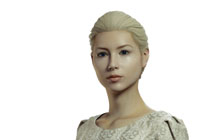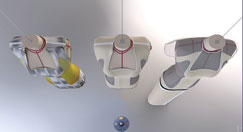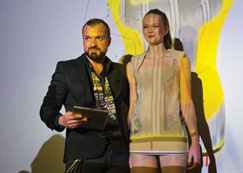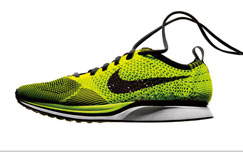Behind the catwalks, champagne parties and celebrity endorsements, fashion design is changing after hundreds of years, embracing a new digital age.

In a world crammed with blogs live from fashion shows, company social media channels pumping out images from backstage, and website articles on every stitch and seam before the week is over, designer collections look tired earlier and leave customers wanting new styles with the immediacy of downloading a track from iTunes.
As the industry becomes truly global, with major brands no longer confined to Europe and North America, business realities have taken hold and companies are venturing into design processes more associated with Porsche than Prada.
The realm of advanced, 3D tools – for design, manufacture, managing store layouts, and stock management – is encompassing the entire process.
Cutting ties
Fashion designers, like architects, have always gripped tightly to their 2D design heritage, but now 3D is making inroads.
The traditional design process is something like this: concept designs are sketched, materials and colours selected, the pattern is laid in 2D with measurement notes.
For the majority of large fashion houses, this is sent to a workshop or factory for a sample prototype to be made, followed by copious tweaks and re-prototyping until a short run batch is made for in-house testing (wearing, washing, fit), and then a production run can be made for sale.
All of this is massively time consuming. Transitions from sketches to patterns take time and precise measurements, a lot still done by hand or using Adobe Illustrator and sent via fax machine.
Clothing sample manufacture takes place as far afield as Bangladesh and China, with prototyping and design iterations taking weeks.
The advancing abilities and use of 3D tools is set to bring speed to this process and transform fashion on a global scale forever.
Fine lines
Taking sketching digital from the earliest stages, it can bridge the process from concept to pattern making, all within a single iteration that can be reused throughout the design process.
The ability to sketch straight onto the screen using compatible hardware, such as a Wacom Cintiq, into a program that allows for sketches to be extruded and manoeuvred into 3D from a simple 2D origin is already amongst us.
Dassault Systèmes has launched Catia Natural Sketch for product designers, although its inspirational Fashion Lab project has taken this a step further.
Projects with couture designer Julian Fournié, as shown at Paris Fashion Week, have given credence to designing in this manner.
Even if it is still a way from reaching commercial reality, the tools allow designers to work in incredible detail, such as fine embroidery.
Already in existence is the Korean design package Clo3D. Originally more accustomed to the world of CGI and videogame costuming (it was used to create virtual character clothing in the film blockbuster The Hobbit), the software is now bridging the gap with physical design elements.
Supporting polyline, free curve and dart drawing, patterns can be modified immediately either through 2D patterns or draped in 3D onto a mannequin, both altering in real-time coercion. It has support for a vast array of traditional tools and methods like multi-layered sewing, tucking and gathering, and adding folds to materials, all of which relate to the 2D pattern for manufacturing instructions.
In-house creation
The creative process is given greater speed and freedom with the abilities for localised prototyping using advances in 3D printing.
Footwear companies have for a long time turned to 3D printing as a means of visualising their designs. Clarks has used the colour printing technology of the ZPrinter to help work on new colourways; while other designers are experimenting using the creative freedoms of shapes it allows, such as the surrealist curves of Victoria Spruce’s collections.
Sportswear giant Nike has gone beyond its initial uses of simply prototyping colourways, and now uses it for developing new materials and styles, such as its complex, woven FlyKnit system that could only have ever made it as a design with the aid of 3D printing.
Accessories such as handbags have also benefitted from the speed and proximity of such methods, and with the ability to mimic textures such as different gauge cloths, leather and snakeskin, it is expected that full garment prints will soon be available.
The shop floor
As manufacturing and shipping costs rise the more localised production is viewed as a viable change to the industry.
Although a dream of 3D printing your own clothes at home is a long way from a cost effective and reliable reality, 3D tools are bringing efficiency already to the production methods of consumer fashion giants.
The option available is managed production runs, taking into account demand and storage – done using PLM systems adapted from mass manufacturing processes similar to those used in the automotive industry.
With the data to hand, from designers down to shop floor, the process can be supervised.
In theory this can feed consumer trends straight back to design teams; production demand to the factories, and check stock levels across the entire network of stores, in transit and coming off the production line.
Both PTC’s FlexPLM and Dassault Systèmes’ Enovia offer PLM systems targeted at the apparel industry, capable of bringing together globally distributed teams.
Although both have their differences, they provide control and management from initial line planning, specification management, merchandising, and other PLM capabilities for managing a company’s assortment of products.
Companies such as Gucci, Nike and Adidas rely on these systems to manage global operations and encompass all the other tools within the lifecycle of a product.
Boutiques and branding
3D tools have the ability to extend all the way down to individual store design, down to a fine level of detail .
With its recent acquisition of Square Clock software, Dassault Systèmes is adding interior design and rendering tools for visual merchandisers into the workflow.With a level of design control so specific to the number of rails and hangars available for stock some retailers no longer need country-specific warehouses; simply monitoring shop stocks day to day via PLM systems.
By adding in such capabilities, Dassault is clearly looking to be the first create a full, 3D-optimised workflow for the fashion industry.
By increasing design creativity, product to market speed and reducing waste, soon the real head-turners at fashion week will be the companies utilising digital technology to the full.
3ds.com
marvelousdesigner.com
ptc.com

Clothing design and manufacture is transformed by cutting edge software
Default










